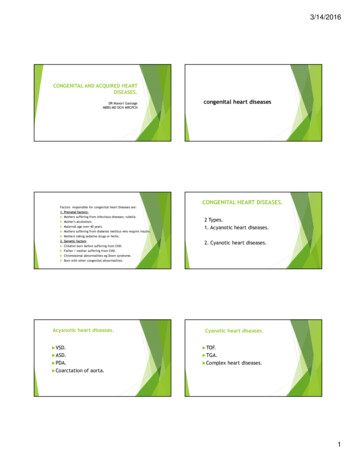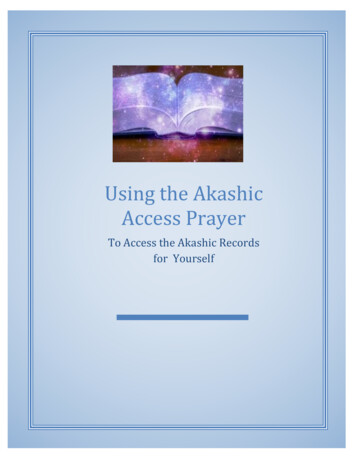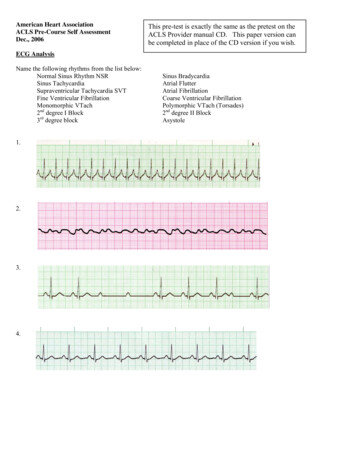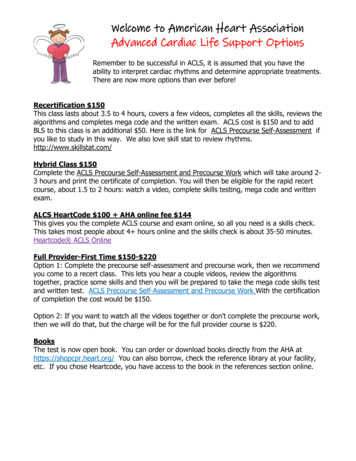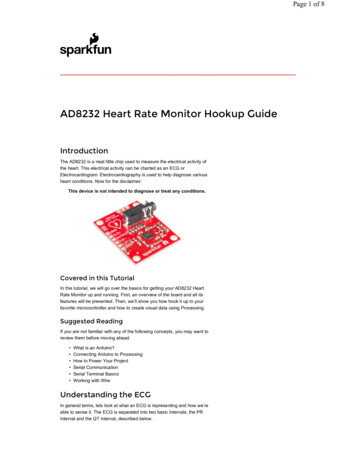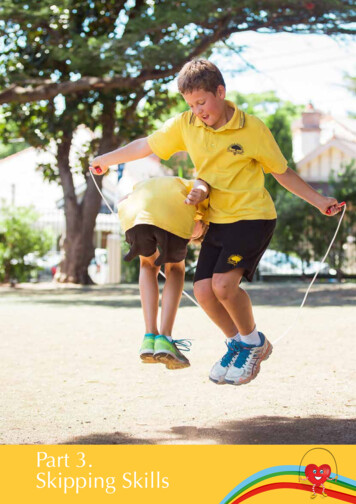
Transcription
Part 3.Skipping Skills
Part 3. Skipping skillsOverviewAustralian children have beenjumping rope with Heart FoundationJump Rope for Heart since 1983.Jump Rope for Heart is renownedfor being one of Australia’s mostpopular physical activity programs.Since its inception, more than 90per cent of all Australian childrenhave participated in this fun, activeprogram.With 25 per cent of Australian children beingoverweight or obese, it is important weshow them that being active can be great funwhile also being very beneficial. Skippinghas a variety of health benefits includingimproved cardiovascular fitness, increasedmuscular strength and endurance, improvedflexibility and coordination, improved timingand rhythm, along with balance and agility,increased social skills and self-esteem, andthe opportunity to be creative.In this section, you will find a variety of toolsand ideas to help you plan your PE lessonsto help students master the art of skippingand all it entails. Students will develop avariety of skills while learning how much funskipping can be and that it is an importantpart of many sport programs.60Teacher’s Manual
JRFH ACTIVITYSTRAND/ SUBSTRANDCONTENTDESCRIPTIONLINKS TO OTHERLEARNING AREASGENERAL CAPABILITIESChallenge 1:Jump StartersMovement andPhysical Activity:Moving our bodyPractice fundamentalmovement skills andmovement sequencesusing different body partsand in response to stimuli(ACPMP008)The Arts- Drama andDanceNUM* Recognising and using patterns andrelationships* Using spatial reasoningPSC* Self-awareness* Self-managementChallenge 2:BeginnersMovement andPhysical Activity:Moving our bodyPerform fundamentalmovement skills indifferent movementsituations (ACPMP025)The Arts-DancePSC-MathematicsNumber and Algebra* Self-awareness* Self-managementChallenge 3:IntermediateMovement andPhysical Activity:Moving our bodyPerform fundamentalmovement skills indifferent movementsituations (ACPMP025)The Arts- DancePSC* Self-awareness* Self-managementPractise and refinefundamental movementskills in differentmovement situations(ACPMP043)Challenge 4:long ropeChallenge 5:AdvancedMovement andPhysical Activity:UnderstandingmovementMovement andPhysical Activity:Moving our bodyIncorporate elements ofeffort, space, time, objectsand people in performingsimple movementsequences (ACPMP029)NUM-Combine the elementsof effort, space, time,objects and people whenperforming movementsequences (ACPMP047)PSC-Manipulate and modify theelements of effort, space,time, objects and peopleto perform movementsequences (ACPMP065)* Generating ideas, possibilities andactionsPerform movementsequences which linkfundamental movementskills (ACPMP044)* Recognising and using patterns andrelationships* Using spatial reasoning* Self-awareness* Self-managementCCT-The Arts- Dance* Self-awareness* Self-management* Social managementPractise specialisedmovement skills andapply them in differentmovement situations(ACPMP061)Challenge 6:Multiple RopesChallenge 7:ChoreographyMovement andPhysical Activity:Learning throughmovementMovement andPhysical Activity:Moving our bodyDesign and perform avariety of movementsequences (ACPMP062)61Teacher’s ManualEU-Participate positivelyin groups and teamsby encouraging othersand negotiating rolesand responsibilities(ACPMP067)Practise specialisedmovement skills andapply them in differentmovement situations(ACPMP061)PSC-* Understanding ethical concepts andissuesPSC* Social awareness* Self-managementThe Arts- DanceMathematicsNumber and AlgebraPSC* Self-awareness* Self-management* Social awarenessNUM* Recognising and using patterns andrelationships* Using spatial reasoning
Selecting theright ropeCorrect skippingtechniqueBefore you start teaching your studentsskipping skills and tricks, you need to showthem how to choose the correct rope. Youhave probably already pulled out your ropesready for lessons and can now see there avariety of different sized ropes. How do youknow which student should use which rope,suitable for their size?Next explain correct skipping technique toyour students. Use this head-to-toe checklistto analyse the movements and form of alearner, and pinpoint any specific problems.Follow these simple steps:3. Arms – at about a 90 angle, held slightlyforward and extended sideways1. Ask your students to hold the handles ofthe rope in both hands.2. Next, ask them to place both their feet inthe centre of the rope, continuing to holdthe handles with each hand.3. With both feet planted on the ground,have them hold the handles up towardstheir shoulders.4. The handles should sit just below theirshoulders – this is the correct sized rope.5. If the rope is slightly too long, simply tiea knot or two at each end of the rope, justbelow the handle. This will shorten therope slightly.62Teacher’s Manual1. Head – held straight, looking ahead2. Shoulders – level and straight, nothunched4. Wrists – move in a circular wrist action toturn the rope5. Elbows – held in close to the body6. Knees – close together with a slight bend.Jumping into PEclassesMany teachers wonder how to includeskipping in their PE classes. We have tworeally simple tools to make tour PE lessons asuccess - skills cards (found in your resourcekit) and downloadable videos (which youcan access here) these are useful tools to giveyou flexibility in how to help students takeownership of their lessons.
Challenge 1: Jump startersStrand: Movement and Physical ActivitySub Strand: Moving our bodyLesson Objective:The Arts- Drama and DanceSkipping at this basic level (jump starters) should be focusedon building confidence to try new activities, developing anappreciation for rhythm, body awareness and gross motorskills.Locomotor skills - Jumping, skippingTo ensure success, make sure skippers are using the rightsize rope (see instructions page 66).Curriculum Objectives:General Capabilities:ACPMP008 Practice fundamental movement skills andmovement sequences using different body parts and inresponse to stimuliNUM* Recognising and using patterns and relationships* Using spatial reasoningPSC* Self-awareness* Self-managementCross Curriculum:Resources:The Arts- Drama and Dance 63Teacher’s ManualMusic CDCD PlayerInteractive Whiteboard (optional)Skipping Ropes
Challenge 1: Jump startersSKILLTEACHING TIPSJumping tomusicPlay some fun music and jump with bothfeet together in time with music.//JumpinggamesMimic animal jumping movements toreplicate the need to jump with bothfeet together. Think of native animals –kangaroo and bilby are our favourites!Jumping relays are fun warm ups.//Jumpingdown thelinePlay games and warm up activitiesfocused around jumping down a linewith both feet together. Tennis courtsare great for this! This will help preparejump starters for skipping in a long rope.//WalkingskipPractise the movement pattern of arms,then feet. Identify the need to move armsover skippers’ heads before they attemptto step or jump over the rope.//SkippingchantsRecite skipping chants to encouragejumping in time with the music. See ourskipping chants section for some funchant ideas.//Extension:Don’t be afraid to try long rope jumping with your JumpStarters. The most important skill is the turning of the rope,ensuring the turner moves to catch the students – whereverthey decide to jump! See the long rope card with moretips on starting the long rope.Once your jump starters have mastered the walking skip,get them to try increasing the speed and distance to buildup confidence.64Teacher’s ManualACHIEVED
Challenge 2: BeginnersStrand: Movement and Physical ActivitySub Strand: Moving our bodyLesson Objective:The Arts- Drama and DanceWhen first learning these skills we encourage skippersto practise withouta rope in order to develop confidencein the basic movement before integrating the arm skills.Make sure the rope is the correct size for the skipperand arms are kept down low on their sides. Skipperswill be deemed competent in this level once they canconfidently perform the skill in eight successive beats.Locomotor skills - Jumping, skippingCurriculum Objectives:General Capabilities:ACPMP025 Perform fundamental movement skills indifferent movement situationsPSCCross Curriculum:Resources:The Arts-Dance Mathematics- Number and Algebra65Teacher’s Manual* Self-awareness* Self-managementSkipping RopesMusic CD (optional)CD Player (optional)
Challenge 2: BeginnersSKILLTEACHING TIPSACHIEVEDSingleBounceJump with both feet together. Tryjumping in time to the beat of a song.//DoubleBounceJump the rope once, followed by a smallrebound bounce.//SkierPractise jumping side to side along amarked line. Remember: little jumps.//BellCount the beat: 1, 2 , 1, 2 as the skipperjumps forwards and backwards.//Side SwingHold hands together in front of bodyand practise the motion of rowing aboat as you swing the rope to each sideof your body.////Some skippers may need assistance tomimic this motion.Face toFaceStart close and facing each other. Learnto skip in time and communicate witheach other.Extension:Try altering the pace and direction of the rope – skipperscan even combine skills to create their own foot patterns!Partner skills: Practise running in and out, turning aroundand touching the ground.66Teacher’s Manual
Challenge 3: IntermediateStrand: Movement and Physical ActivitySub Strand: Moving our bodyLesson Objective:The Arts- Drama and DanceWhen first learning these skills we encourageskippers to practise without a rope in order todevelop confidence in the basic movement beforeintegrating the arm skills. The skipper will be deemedcompetent in this level once they can confidentlyperform the skill in eight successive beats.Locomotor skills - Jumping, skipping, balancing, hoppingCurriculum Objectives:General Capabilities:ACPMP025 Perform fundamental movement skills indifferent movement situationsPSCACPMP043 Practise and refine fundamentalmovement skills in different movement situations* Self-awareness* Self-managementCross Curriculum:Resources:The Arts-Dance 67Teacher’s ManualSkipping RopesMusic CD (optional)CD Player (optional)
Challenge 3: IntermediateSKILLTEACHING TIPSCriss CrossHug your hip, ensuring hands are clearto the side.ACHIEVED//Glue feet to the ground to practise thearm movement – before adding a jump.TwisterKeep arms low to the side and maintaina normal arm pattern as you twist!//JoggingStepPlay music with a great beat and jog intime with the music. Try to lift one footat a time for each rope turn.//LinkJumpingStart with a longer rope for each skipper.//180 TurnPractise a side swing and follow the ropearound until you are facing the oppositedirection.////Stand directly beside each other andcommunicate the pace and timing foreach jump.Make sure hands are brought together asyou make the turn.Arms need to be opened wide beforeyou start skipping backwards.Face toFaceStart close and facing each other. Learnto skip in time and communicate witheach other.Extension:Try these skills backwards and increase the pacefrom double to single bounce.68Teacher’s Manual
Challenge 4: Long ropeStrand: Movement and Physical ActivitySub Strand: Moving our bodyLesson Objective:The Arts- Drama and DanceThere are a range of games and skills you canpractise with a long rope. Long rope skipping is agreat way to encourage teamwork and is great forconfined spaces.Locomotor skills - Jumping, skipping, balancing, hopping,runningTips: Make sure you always turn the rope towardsthe skipper. Skippers should enter and form a linedirectly beside the turner.Curriculum Objectives:General Capabilities:ACPMP029 Incorporate elements of effort, space,time, objects and people in performing simplemovement sequencesNUM* Recognising and using patterns and relationships* Using spatial reasoningACPMP047 Combine the elements of effort, space,time, objects and people when performing movement PSCsequences* Self-awareness* Self-managementACPMP065 Manipulate and modify the elements ofeffort, space, time, objects and people to performmovement sequencesCross Curriculum:CCT* Generating ideas, possibilities and actionsResources: 69Teacher’s ManualSkipping RopesTape to mark the floorMusic CD (optional)CD Player (optional)
Challenge 4: Long ropeLEVELTEACHING TIPSJump startersStart in the middle of the rope.Skippers watch the rope go over their head as a cue for when to jump.ACHIEVED//////Teachers can assist by varying the pace of the rope to catch the skipper as wellas calling out when to jump.Level 1Stand directly beside the teacher with two marked areas: one for where to startand one for where to run to.Place a hand on the back of the skipper and encourage them to enter the ropewith a light push.Once they reach the second mark – JUMP!Level 2Skippers should be able to run in and out of the ropes independently, performinga few jumps down the rope before exiting.Try a figure of eight and build up to increase speed and endurance.Level 3Don’t miss a beat – skippers should aim to have someone in the rope every timethe rope is in the air.//Level 4Include equipment and challenge skills such as push ups and touching theground.//70Teacher’s Manual
Challenge 5: AdvancedStrand: Movement and Physical ActivitySub Strand: Moving our bodyLesson Objective:The Arts- Drama and DanceLocomotor skills - Jumping, skipping, balancing, hoppingWhen first learning these skills, we encourageskippers to practise withou a rope in order to developconfidence in the basic movement before integratingthe arm skills. Beginning slowly is the key!The skipper will be deemed competent in this levelonce they can confidently perform the skill in eightsuccessive beats.Curriculum Objectives:General Capabilities:ACPMP044 Perform movement sequences which linkfundamental movement skillsPSCACPMP061 Practise specialised movement skills andapply them in different movement situations* Self-awareness* Self-management* Social-managementCross Curriculum:Resources:The Arts-Dance Skipping RopesMusic CD (optional)CD Player (optional)The skipper will be deemed competent in this le
Teacher’s Manual Challenge 1: Jump starters Strand: Movement and Physical Activity Sub Strand: Moving our body Lesson Objective: The Arts- Drama and Dance Skipping at this basic level (jump starters) should be focused on building confidence to try new activities, developing an appreciation for rhythm, body awareness and gross motor skills. To ensure success, make sure skippers are using the .



